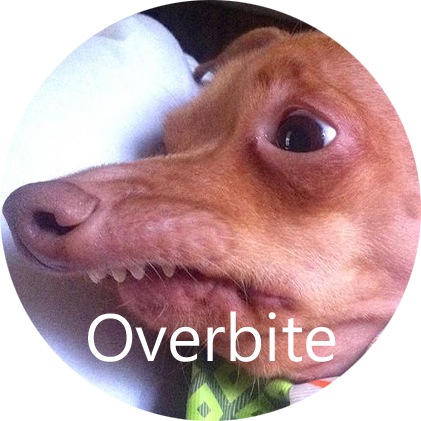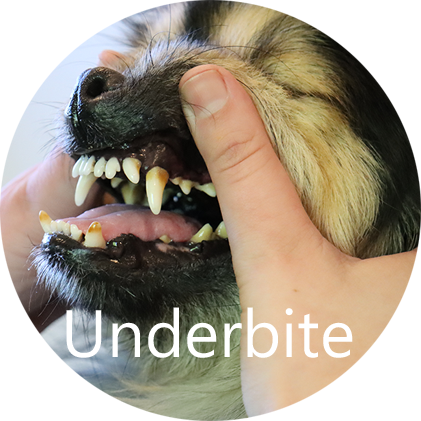These two terms are easy to confuse. They both refer to a malocclusion- a condition where a dog’s or cat’s (or person’s) teeth do not line up normally. But which is which? How do you know if your pet has an overbite or underbite? And is it something you should be worried about?
First things first … what is normal?
Dogs and cats have four types of teeth- incisors (the little ones at the front), canines (the long pointy ones), premolars (the front cheek teeth) and molars (the back cheek teeth). Normal occlusion means the teeth line up properly with each other. Specifically:
- The upper incisors are just in front of the lower incisors.
- The lower canines sit in between the last upper incisor and the upper canine.
- The premolars fit together in a zig-zag pattern.
- None of the teeth push into the soft tissues (gums or cheeks or roof of the mouth).
- None of the teeth contact each other (except the molars at the back).
If your pet meets these five criteria, then congratulations- they have normal occlusion! Many pets, however, suffer from one or more type of malocclusion. For certain dogs it is even part of the ‘breed standard’ to have a malocclusion (an issue which we’ll leave for another time). How to tell if you pet has an overbite, underbite or something else entirely? Read on …
Overbites- Class 2 malocclusions

An overbite is when the lower jaw is too short relative to the upper jaw (think Santa’s Little Helper from the Simpsons). Overbites occur most commonly in long-nosed breeds like Collies, German Shepherds, Dachshunds, Greyhounds etc. To remember: think over=upper. In an overbite, the upper jaw sticks out.
Underbites- Class 3 malocclusions

An underbite is when the lower jaw is too long relative to the upper jaw (think Muttley from Wacky Races). Underbites occur most commonly in short-nosed breeds like Pugs, Boxers, French Bulldogs, Shih Tzus, Boxers etc. Short-nosed cats such as Persians and Himalayans can also be affected. To remember: think under=lower. In an underbite the lower jaw sticks out.
Other malocclusions
Class 1 malocclusions are when individual teeth are rotated or angled or positioned abnormally. A common example is when the lower canines are pointing up towards the roof of the mouth rather than sliding along the outside of the gums- this is known as base-narrow canines. Class 4 malocclusions occur when one side of the jaw is shorter/longer than the other- this often due to trauma or surgery to remove part of the jaw, and is also know as wry-bite.
When is malocclusion a problem?
Dogs and cats do not need perfect occlusion, but they do need pain-free occlusion. Anyone who has bitten their cheek or tongue knows how much it hurts. If an overbite, underbite or other malocclusion is causing the teeth to hit the soft tissues of the mouth (be it the roof of the mouth, gums, or cheek) it is termed a traumatic malocclusion and it requires treatment. Similarly, if a malocclusion is causing teeth to grind against each other that also requires treatment. Therapy needs to be tailored to each individual, and may require a specialist veterinary dentist. Treatment options that can help to achieve a pain-free bite can include tooth extraction, crown reduction, or orthodontics (gradual repositioning of the teeth).
Disclaimer: The information and advice in this post is general in nature. It is not intended as a substitute for tailored health care advice from your regular veterinarian.

